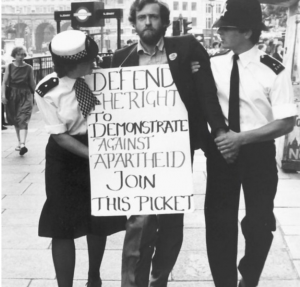There is an online meme. I’m unsure whether you are aware of it. One of the most debased versions of it is a pairing of two photos, the first being the infamous Bullingdon Club photo showing a youthful David Cameron and his drinking club at college, the second showing the below photo, and asking us to compare and contrast:
I’ve always thought the comparison somewhat unfair. Cameron at the point his photo was taken (1987) was a 21 year old student. Corbyn, in comparison, in his photo (1984) was a 35 year old politician who had been an MP for a year and was first elected to office (as a councillor) a decade before.
I’m pretty politically minded myself, but if you are going to ask me what I was doing at 21, the main answer would be “getting drunk and having fun”. The fact I never chose to dress up in quite frankly archaic looking gear, or that my drinking companions weren’t particularly posh doesn’t negate the fact that Cameron was pictured doing something pretty normal for people of his age.
As I say, that’s a debased version of the meme. I’ve seen more debased variants that compare Corbyn to Cameron “who at the time was wearing ‘Hang Nelson Mandela’ t-shirts”, ignoring the fact that it was, generally agreed, mainly a small group of individuals who wore badges rather than t-shirts with the slogan, and that Cameron was not one of them. No evidence exists for the claim, but it inhabits that peculiar area of modern folk tale amplified by the Internet. The country we could call Memeland.
But I digress from my main purpose.
The least debased summation of the meme was made by Hugh Lovatt in the IB times in September 2015.
“Looking back over the past 30 years, Corbyn has proved to be remarkably prescient. He was a staunch supporter of the ANC’s struggle at a time when the British government was still largely supportive of the Apartheid government”
What’s illustrative about this quote is that there is only one element of it that is undeniably true – that Corbyn was a supporter of the struggle. The rest is hazy misremembering and myth making flattening out history.
To begin at the beginning – the precursor of the British anti-apartheid movement was set up in 1960 by a number of luminaries, one of which was the then Labour Party leader, Hugh Gaitskell.
In 1961, the then Tory Prime Minister Harold MacMillan gave his famous “winds of change” speech in Cape Town, telling the South Africans directly that their policies were against the tide of history.
In 1969 and 1970, the stop the 70 campaign, chaired by future Labour Party minister Peter Hain aimed to disrupt the Springbok rugby tour of the U.K.
By the early 80s partial bans were in place regarding sport, and partial economic sanctions were due to come. The Special Aka had a top 10 hit with Free Nelson Mandela in 1984. In Bill Forsyth’s surprise hit of 1983, Local Hero, there is a scene where Denis Lawson finds washed up on the beach an orange and swears, because it is South African. Globally, the movement was huge. It had UN backing. It dominated campus life in the west, and had done since the mid-70s.
The younger me proudly had an Anti-apartheid badge, which I would wear daily. It’s estimated around 90% of Trade Union at the time supported the anti-apartheid movement, and the vast majority of Labour MPs. One could go on at length but the point is, however staunch Mr Corbyn’s opposition to apartheid was, it was neither prescient nor remarkable.
What was remarkable about it was it remains one of the most mainstream opinions he’s ever had.
The third element of the quote, too, is wrong. The idea that the British government supported South Africa was given credence at this point from their opposition to complete sanctions. Indeed, David Cameron has gone on record to criticise Thatcher’s policy of “positive engagement”, so it’s obviously an idea that has sunk into political culture. The only thing is, it’s not quite the whole picture.
When Thatcher met PW Botha at Chequers in 1984, the South African foreign minister’s notes of the meeting highlight that she “very firmly” told him that Mandela should be released, apartheid dismantled, and the forcible removal of urban blacks had to stop. At a statement to the House of Commons regarding the meeting she reiterated those points. This was welcomed by Archbishop Trevor Huddlestone, one of the leading lights of the anti-apartheid movement, President of the AAM at the time.
Whilst the mythology of Thatcher as an unabashed supporter of apartheid has taken hold, even when the diplomatic history shows the story to be far more nuanced, I don’t want to over-egg the pudding. Undoubtedly, Thatcher could have done more. Also, undoubtedly, perfidious Albion could well have been motivated just as much by economic (or geo-political – this was still the height of the Cold War and the ANC was still formally communist) considerations with respect opposition to complete sanctions as it could have been motivated by a different idea of how to resolve the situation (however, to give a little more context, it was under Thatcher that the ongoing Zimbabwe/Rhodesia struggle was resolved, and her government played a major part in the negotiations that led to black majority rule. So the idea that she was motivated by some atavistic sympathy for racist colonialist states is not quite the whole ticket).
However, the above caveats caveated, it’s pretty clear that the image of Jeremy, the prescient rebel against the system, is a distortion of the truth to almost heroic degrees.
Which brings us to the photo.
In 1984, ahead of Botha’s visit to the UK (the very same visit, you will recall, during which Mrs Thatcher “very firmly” set out her position), the Metropolitan Police moved to deal with a non-stop picket of the South African embassy that the City of London branch of the Anti-Apartheid movement had set up.
Said London branch was dominated at this point by members of the Revolutionary Communist Group, a Leninist group whose name does exactly what it says on the tin (amongst their many charming positions was a fondness for the Pan Africanist Congress slogan “one settler, one bullet”, a slogan that even the PAC never adopted formally and has since apologised for. The PAC were, by the way, always a fringe organisation in the struggle against apartheid and held little relevance to its end), and The Workers Revolutionary Party (the grubbiest of all the British far left parties, led as it was by Gerry Healey, a serial rapist who took money from Gadaffi and Saddam Hussein to spy on London based dissidents).
The Anti-Apartheid movement as a whole – the group that had both the blessing of and took their lead from the ANC, the dominant political organisation of black South Africans, the actually existing people who were suffering under apartheid – attempted to challenge this through the courts and also entered into negotiations with the police to try and resolve the situation.
The City of London branch, on the other hand, called a demo, ignoring the AAM’s wishes, during which Corbyn was one of three MPs arrested.
This ongoing conflict between the AAM and the City of London branch, by the way, eventually led to the expulsion of the City of London branch from the movement in 1985 (the same year, incidentally, that Gerry Healy’s reign as Dictator of the WRP fell apart over the allegations of sexual abuse and complicity with dictatorships mentioned above. He died in 1989. In 1994, Ken Livingstone claimed all the allegations against him were a secret service frame-up. Just so you understand the milieu).
So, what actually emerges from our brief potted history of a picture of Jeremy on a demo is not a lone man, prescient in his opposition to the evil apartheid regime.
Instead, it is a man who – when an idea is already mainstream and backed by the vast majority of the left – finds himself drawn to a demonstration organised by those on the wildest shores of it, a demo the utility of which – centred entirely around the right to keep a non-stop picket outside an embassy – to the wider cause of the movement is debatable, to say the least.
Staunch opponent of apartheid Jeremy may very well have been (and I don’t for one moment doubt his sincerity), but he deserves no special plaudits for holding such a mainstream left position, and his choice of allies and associates yet again gets shown up to be, well, questionable to say the least.
But sure. Keep sharing that picture. Right side of history. Prescient.
(Thanks to James Undy for inspiration and first hand reminiscence of the period)



